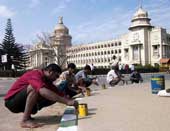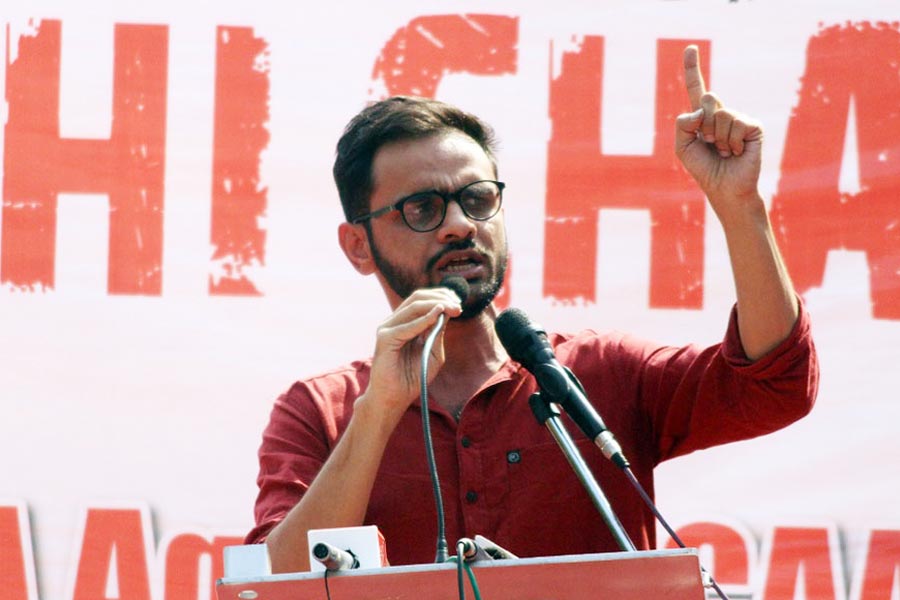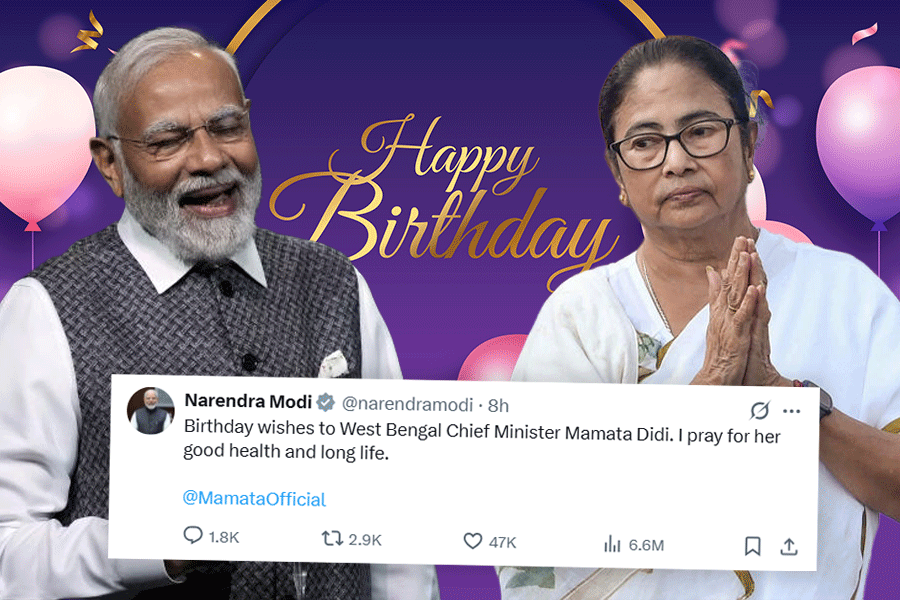|
|
| Squalid underbelly |
Calcutta is ready for an image makeover. The chief minister, Buddhadeb Bhattacharjee, has announced that hand-pulled rickshaws will soon be taken off the streets. The reasons he has given for the decision are solid and unromantic: it is an inhuman practice and exists nowhere else. The chief minister has also said that alternative arrangements will be made for the nearly 24,000 men who will lose their jobs, although he has not specified what they will be. Illiterate, unskilled and often quite old, one is not sure whether many of these rickshaw-pullers will not end up as coolies in the Posta or Koley market, or in a job no less inhuman.
But one can understand the chief minister?s concerns. The image of a gaunt man yoked to the long handlebars of a rickshaw like an animal, running, has a stark visual quality that is not found in other forms of menial labour. Even the little bells these men carry to warn passersby evoke an equine analogy. Most important, the rickshaw is one of the most well-known symbols of the city, along with the Victoria Memorial, the Ochterlony Monument, tramcars and the Howrah bridge ? all, interestingly, legacies of the raj.
About two decades ago, the French writer, Dominique Lapierre, gave the taana rickshaw an almost iconic status when he made Hasari Pal, a rickshaw-puller, the central character of his bestseller, The City of Joy. The writer used to carry a little brass bell, a gift from a rickshaw-puller, and jingle it at talk shows around the world. A section of Calcuttans took offence at such a portrayal and matters took an ugly turn when the Hollywood director, Roland Joffe, came to Calcutta to film The City of Joy.
Given all this, and also the Bhattacharjee government?s determination to overturn the antiquated image of Calcutta and woo foreign investors, the decision to ban hand-pulled rickshaws makes a lot of sense. This mode of transport is restricted to the central and northern parts of the city and, although they have their uses on water-logged streets, people can and must learn to do without them.
Behind the decision to banish something that has been an inalienable part of the city?s roadscape for so long, there is surely a fresh outlook. But the question is: are we prepared to accommodate that outlook in our cultural sensibility? What is the nature of this sensibility and how does it cope with the stark, brutal reality that unfolds every day on the streets of Calcutta?
Back in the Eighties, the Calcutta Municipal Corporation put out an advertisement in newspapers and magazines in which the photograph of a naked street urchin crossing a busy street was superimposed on the text of Nirendranath Chakravorty?s famous poem, ?Kolkatar Jishu?. In it, the poet presents a beggar?s child ? the Jesus of Calcutta ? halting the rush of traffic as he calmly crossed the street. Capturing the grim, everyday face of the city, it is nevertheless a deeply romantic vision that the poet experiences from the window of a moving bus. What prompted the civic body to use this poem in an ad? What message did it want to convey?
Perhaps as a sort of antidote, it issued another set of advertisements bearing a wistful line from Jibananda Das ? Kolkata ekdin kallolini tilottama hobey (One day, Calcutta will be a vibrant paragon). Such public relations exercise continued for decades while basic civic facilities in the city turned abysmal and slums were allowed to grow and fester everywhere.
Calcutta has received a lot of bad press internationally since the days of the raj. From Rudyard Kipling to G?nter Grass, from Norman Lewis to V.S. Naipaul, writers and artists from the West have portrayed it as a nightmarish city teeming with starving millions. But it was in the Seventies that the negative image stuck indelibly. This was a most harrowing decade: waves of refugees from East Pakistan, political violence on the streets, capital going out of the state, mills and factories closing down, the continued migration of labour from neighbouring states, the great flood of 1978, the power cuts...the list of miseries was endless.
Rajiv Gandhi was only voicing a perception popular in other parts of India when he called Calcutta a dying city. Expectedly, Calcuttans? reactions to such criticisms have been strong and passionate ? ranging from shooting off angry letters in newspapers to throwing petrol bombs at film-sets.
Strangely, however, when it came to taking a re-look at the city, we seem to have borrowed the same Western looking glass. In other words, the image of Calcutta that we despised so much was the only image of the city that we have had. This explains the ?Kolkatar Jishu? ad. The CMC seemed to be saying: ?Look, ours is a wretched city where naked, homeless children roam the streets, but doesn?t it throb with poetry and humanity!? The same message is to be found in Lapierre?s The City of Joy and Grass?s The Flounder and Show Your Tongue, books that raised a furore. In the depictions of Calcutta in our own cinema, theatre and literature, one sees variations of the same stereotype. After all, much of our artistic engagements with contemporary urban reality have been mediated by a Goddard, a Brecht or a T.S. Eliot.
In this age of visual communication and brand marketing, image does matter, though it may not always reflect the true face. So what if half the population of Calcutta lives in slums, as many are illiterate, 40 per cent lives below the poverty line and 70 infants in a thousand die at birth? At least the people of the city will now be spared of the sight of these ?human horses?.
It would be great if this inspires us to take a re-look at the other sordid spectacles unfolding daily before our eyes, in nooks and crevices of the city, under bridges and in canalside settlements. Modern third-world metro-polises have found two convenient ways of doing away with such ugly sights: by setting on bulldozers, or by building subways and flyovers so that their prized citizen can zip past them. Calcutta must look for a third option.











